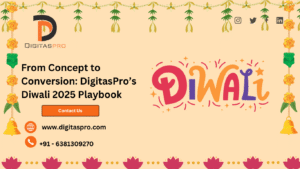In today’s digital-first world, search engine optimisation (SEO) remains one of the most powerful levers for organic growth. As search engines evolve—powered by artificial intelligence, mobile indexing, and user-experience signals—the rules of the game are shifting. Yet, there are still foundational “golden rules” which, when consistently followed, deliver sustainable results. Below, we explore 20 of those key rules, and how a forward-thinking agency like DigitasPro Technologies embeds them into their approach.
1. Match Search Intent
What to Do: Study top results and align your content to what the user actually wants.
Why It Matters: If you solve the user’s query, search engines reward you.
At the heart of modern SEO is understanding why someone is searching. Are they looking to buy? To research? To compare? Are they asking a question (informational), wanting a solution (transactional), or seeking a local service (local-intent)? Your content must match that intent.
How DigitasPro works this out
When engaging with a client, DigitasPro begins with a deep audit of the search results for target keywords: looking at the types of pages ranking (blog posts, product pages, videos, FAQs). They then map the content format and tone to user intent. For example, if users searching “buy running shoes Chennai” see mostly product pages and comparison tables, then the strategy is geared accordingly.
2. Show Real Expertise
What to Do: Add author proof, credentials, case studies or client proof.
Why It Matters: Builds trust fast—humans and search engines both care.
Search engines increasingly value E-A-T (Expertise, Authoritativeness, Trustworthiness). A page by a named expert, with citations or proof of results, will perform better than anonymous, bare-bones content.
DigitasPro’s approach
On their website you’ll see real team profiles and client testimonials—showing that their work is backed by people, not just generic statements. DigitasPro Technologies+1 They position themselves as a full-service partner, not a one-trick pony.
3. Optimize for AI
What to Do: Use clear, direct answers; structured content; natural language.
Why It Matters: AI-driven search features (like Google’s models) will better understand your page.
Search behavior and ranking signals are shifting. Instead of strictly matching keywords, the user experience around AI-driven results, voice search, and featured snippets becomes important. Content must be well-structured, easy to parse, and helpful.
Practical tactics
- Use H1/H2s that reflect questions (e.g., “What is …?”, “How to …?”)
- Write short-paragraph answers to match snippet style
- Use schema markup (see rule 9) to give machines structured signals.
DigitasPro explicitly mentions optimizing for AI and natural language in their blog.
4. Improve Page Speed
What to Do: Compress images, leverage caching, optimize code, use a CDN.
Why It Matters: Faster sites keep users longer and get better rankings (bounce-rate & UX).
User experience is central to SEO. If your site takes ages to load, users bounce — and search engines note that. Google’s Core Web Vitals emphasise this.
DigitasPro’s method
When building websites, they emphasise performance: from image compression, code minification, lazy loading, to mobile-first testing. Their process for local sites (e.g., Port Blair) shows performance built in from Week 6 of the project.
5. Mobile-First Design
What to Do: Test on phones, tablets; ensure responsive layouts; prioritise mobile user flow.
Why It Matters: Google uses mobile-first indexing; many users browse exclusively on mobile.
A desktop-only site no longer cuts it. Your pages need to load quickly, display correctly, have mobile-friendly navigation and readable text.
DigitasPro’s practice
They emphasise mobile behaviour in their discovery phase and design wireframes with mobile in mind, ensuring low-bandwidth and slower connections aren’t neglected (especially for local or emerging markets).
6. Use Topic Clusters
What to Do: Build related pages around a main topic and link them together internally.
Why It Matters: Boosts topical relevance and site structure; helps crawlers and users.
Instead of one standalone blog post, use a “pillar” page plus “cluster” pages that link back to it — creating a network of content that reinforces authority on a topic.
DigitasPro strategy
Within their content strategy, they emphasise internal linking, creating hub pages with supporting articles, helping clients dominate niche topics (such as local service keywords) rather than isolated pieces.
7. Write Original Content
What to Do: Avoid copy-text, reuse, duplicate content; aim for unique value and brand voice.
Why It Matters: Builds authority and avoids penalties; Google rewards unique, helpful content.
Originality matters — not just for SEO, but for user trust. If your content adds nothing new, you risk being lost in the noise or penalised.
How DigitasPro delivers
Their service emphasises “uncompromising quality” and original messaging for each client. They don’t rely purely on templates or recycled content.
8. Fix On-Page SEO
What to Do: Titles, meta descriptions, H1/H2s, alt text, URL structure — all optimised.
Why It Matters: These signals tell search engines what your page is about.
On-page SEO remains foundational. Before chasing backlinks, ensure your pages have strong on-page signals.
Practical implementation with DigitasPro
They include on-page baseline in audits and development sprints. As noted in their local site build process (Port Blair) they set up title/meta, schema, internal linking, etc. from the outset.
9. Add Schema Markup
What to Do: Use structured data (FAQ, HowTo, Article, LocalBusiness, Product) to give extra context.
Why It Matters: Enables rich results, featured snippets, higher visibility in SERPs.
Structured data helps search engines better understand your content and can yield enhanced results (rich snippets) which can boost click-through rates.
DigitasPro’s approach
Their local SEO and web-design process explicitly includes schema markup (e.g., for local businesses).
10. Target Snippets
What to Do: Format concise answers, bullet lists, tables, FAQ sections — aim for zero-click results.
Why It Matters: Featured snippets appear above traditional results; being there can yield high-visibility traffic.
Tailoring some of your content to address common questions directly and clearly can earn you position 0 in Google and other search engines.
Work by DigitasPro
They create content and pages optimised for user questions, natural language queries, and snippet-friendly formats — part of their AI- and voice-search readiness.
11. Refresh Old Posts
What to Do: Regularly update content for accuracy, relevancy, new data, and search intent shift.
Why It Matters: Keeps rankings strong; prevents decay of traffic; signals freshness to search engines.
A blog post written two years ago may be outdated in terms of data or user intent. A refresh can revamp its life and boost performance.
DigitasPro’s best practice
In their ongoing care plans (after website launch) they include periodic content audits, updates, and refreshes as part of delivering long-term organic growth.
12. Build Good Links
What to Do: Earn high-quality, relevant backlinks from niche sites, authoritative domains, not spammy ones.
Why It Matters: Links remain a major ranking signal; quality > quantity.
Link building is labour-intensive but worth it. The right links amplify authority; the wrong ones can harm.
DigitasPro’s link-building stance
Their SEO services emphasise “niche links” and sustainable off-page strategies rather than shortcuts or black-hat methods. For example, their Dubai SEO blog recommends earning high-quality Arabic/English links.
13. Add Internal Links
What to Do: Connect key pages (pillar pages → cluster pages), use anchor text wisely, create clear site structure.
Why It Matters: Improves crawlability, distributes link-equity, helps users navigate.
Internal linking is often under-used yet is a powerful way to guide both users and search engines through your content ecosystem.
DigitasPro in practice
In their website design process they build navigation and internal links as part of the baseline—not just after launch. Their SEO audits include internal link structure checks.
14. Speed Up Site (Media & UX)
What to Do: Optimise images/videos, lazy-load media, reduce render-blocking resources, use modern formats (WebP/AVIF).
Why It Matters: A fast, responsive site delivers better UX — and good UX improves SEO.
Performance isn’t just about raw speed; it’s about how quickly users can engage with your content.
DigitasPro’s execution
When building sites (e.g., for local services in slower connectivity markets) they account for image optimisation, caching, low-bandwidth constraints, and test via Lighthouse/Core Web Vitals.
15. Voice Search Ready
What to Do: Use natural phrases, answer conversational queries, include FAQ schema and long-tail questions.
Why It Matters: As voice search and smart assistants grow, queries become more conversational.
Users might ask “Which hotel near Dubai Mall has rooftop pool?” instead of typing keywords. Your content must reflect this shift.
DigitasPro’s forward look
Their blog on Dubai SEO references Voice & AI-driven adaptation explicitly. They encourage conversational phrasing, natural-language keywords, and snippet-friendly formatting.
16. Add Visuals
What to Do: Use images, videos, infographics, diagrams—and optimise alt text, captions, and sizes.
Why It Matters: Visual content boosts engagement time, shares, and helps convey information more effectively.
A page full of dense text is unlikely to engage users — visuals break up content and improve retention.
DigitasPro’s integrated strategy
Their services include branding and graphic design, not just SEO. They recommend combining visuals with content for better engagement
17. Optimize Local SEO
What to Do: Claim/verify your Google Business Profile (GBP), manage NAP (Name-Address-Phone) consistency, get local citations, optimise for “near me” keywords.
Why It Matters: For service businesses, local search drives high-intent traffic and conversions.
Local SEO has its own special signals. If you’re a physical business, you can’t ignore them.
DigitasPro’s expertise
Their case study for Dubai highlights local SEO tactics: bilingual pages, Google Business Profile optimisation, local directory citations. For Indian clients, they emphasise mobile + low-connectivity optimisations.
18. Improve Accessibility
What to Do: Use meaningful alt text, ensure contrast meets WCAG, support keyboard navigation, captions for video.
Why It Matters: Accessibility improves user experience, which is a ranking signal; plus it broadens your audience.
Search engines care about overall user satisfaction—and accessibility plays into that.
DigitasPro’s standard
When building websites, the agency flags accessibility during wireframe stage (especially for local markets). Their build documentation highlights “Accessibility (WCAG-minded): contrast, keyboard navigation, ARIA labels”.
19. Track Performance
What to Do: Regularly monitor key metrics—organic traffic, ranking drops, bounce rate, conversions, Core Web Vitals.
Why It Matters: SEO is ongoing; you must measure what works and what doesn’t to iterate.
Without tracking, you’re flying blind. The best optimisation is data-driven.
DigitasPro’s reporting
They offer analytics dashboards (GA4 + privacy-friendly options), and quarterly strategy reviews. Client reports outline keyword rankings, traffic trends, conversion rates, and recommendations.
20. Fix Technical Issues
What to Do: Ensure HTTPS, sitemap.xml, robot.txt, proper redirects (301s), canonical tags, clean code, crawl error resolution.
Why It Matters: Technical health is the foundation — without it, other SEO efforts may fail to be recognised.
Many SEO campaigns fail because the site has crawl issues, poor indexation, or broken architecture.
DigitasPro’s baseline
In their discovery & build process they include technical audit, sitemap setup, migrations with proper redirects, and crawl-path optimisation. Their local website build process emphasises “SEO baked in, not bolted on”
How These 20 Rules Fit Together — A Holistic Approach
Just focusing on one or two rules won’t guarantee success. SEO today is like a symphony — each part must play its role, in harmony. The rules above span content, technical, UX, performance, and link building. A full-service agency approach brings all pieces together.
Here’s how a typical engagement with DigitasPro might look:
- Discovery & Audit – They assess current SEO health: speed, mobile experience, technical issues, content gaps, intent mapping.
digitaspro.in+1 - Strategy Definition – Based on the audit, they decide target keywords, intent-mapping, content clusters, link-building approach, local thrust (if applicable).
DigitasPro Technologies+1 - On-Page & Technical Implementation – They build/optimise pages: titles/meta, schema, mobile design, internal linking, performance optimisation.
digitaspro.in+1 - Content & Authority Building – Produce original content, visuals, blog posts, and earn quality backlinks for niche authority.
DigitasPro Technologies+1 - Local & Accessibility Focus – If local business, claim GMB, build local citations; always ensure accessibility and mobile-friendly design.
DigitasPro Technologies+1 - Monitoring & Refinement – Use analytics to track performance, iterate on pages, refresh old content, fix issues discovered in reporting.
digitaspro.in
Why Partnering with DigitasPro Technologies Makes Sense
If you’re looking for an agency to help with SEO, here are compelling reasons to consider DigitasPro:
- Full-service capability: They’re not just an SEO agency—they do web design, development, branding, content, and digital marketing. This means your SEO is aligned with the overall user-experience and brand strategy. DigitasPro Technologies+1
- Data-driven and transparent: They highlight “data, discovery, testing” as key to their marketing strategy. DigitasPro Technologies
- Affordability and scalability: For small and mid-sized businesses, especially in India or for global outreach, they offer cost-efficient SEO services with expertise in international markets (like UAE). DigitasPro Technologies+1
- Local and international reach: With roots in Chennai/Tambaram and ability to serve Dubai/UAE clients, they demonstrate versatility. DigitasPro Technologies+1
- Modern SEO mindset: They explicitly reference AI tools, voice search readiness, and niche SEO strategies rather than cookie-cutter approaches. DigitasPro Technologies+1
Sample Implementation for a Business
Let’s walk through a hypothetical example of how these rules would apply for a business — say a boutique hotel in Dubai — working with DigitasPro.
Step 1: Audit & Intent Mapping
- Identify target keywords such as “boutique hotel Dubai downtown”, “luxury hotel near Dubai Mall with rooftop pool”, “family-friendly hotel Dubai”.
- Study the top results: Are they showcasing room photos, rooftop pool features, booking engines? Map intent: likely transactional + local.
- Identify site speed, mobile experience, local listing health.
Step 2: Strategy
- Create a pillar page: “Boutique Hotel Dubai – Ultimate Guide”
- Cluster articles: “Rooftop pool hotels in Dubai”, “Family-friendly hotels near Dubai Mall”, “Budget boutique hotels Dubai”.
- On‐page: Title tags, meta descriptions, H1s aligned with transactional intent (“book rooftop pool boutique hotel Dubai”).
Step 3: Technical & On-Page
- Ensure HTTPS, sitemap.xml, robot.txt, canonical tags.
- Use schema markup: Hotel, LocalBusiness, FAQ.
- Mobile-first design, compress images of rooms, lazy load galleries, test with mobile emulators.
- Add internal links: from blog cluster pages back to the pillar page; navigation menus optimised for mobile.
Step 4: Content & Authority
- Write original blog posts highlighting unique features (rooftop pool, Dubai Mall access, family suites), with high-quality photos and video tours.
- Use internal linking as described.
- Acquire backlinks from relevant travel blogs, Dubai tourism directories, local UAE publications.
Step 5: Local SEO & Accessibility
- Claim/update Google Business Profile (GBP) with accurate NAP, categories (Hotel, Boutique Hotel).
- Solicit guest reviews, respond promptly.
- Ensure alt-text for images (e.g., “rooftop pool hotel Dubai”), provide accessible navigation for mobile users, ensure colour contrast meets accessibility standards.
Step 6: Monitoring & Refinement
- Track key metrics: organic traffic, keyword positions for “boutique hotel Dubai”, bookings via organic, bounce rate on mobile.
- Refresh older posts every 6-12 months (e.g., update blog on “best boutique hotels Dubai 2024”).
- Identify and fix any emerging technical issues (e.g., hopped URLs, crawl errors).
- Use voice-search readiness: optimize for queries like “which boutique hotel in Dubai has rooftop pool”.
This holistic approach aligns with the 20 golden rules and ensures your SEO programme is not piecemeal but integrated.
Common Pitfalls & How to Avoid Them
Even with the right rules, many businesses stumble. Here are common mistakes and how DigitasPro helps avoid them:
- Focusing only on keywords but ignoring user intent — DigitasPro starts with intent rather than keyword volume.
- Building fast links with no relevance — They emphasise niche-relevant link building.
- Designing desktop-only websites — They prioritise mobile-first and performance in low‐bandwidth conditions.
- Publishing blog posts and forgetting them — They include content refresh cycles in their care plans.
- Neglecting local SEO — Many businesses ignore local citations and GBP; DigitasPro covers not just global but local thrusts.
- Ignoring technical health — Without redirects, sitemaps, clean architecture, even great content might not be seen; DigitasPro’s build process includes these foundations.
The Future of SEO & Why These Rules Still Matter
As search engines evolve, with AI models, voice interfaces, mobile-only indexing and richly multimedia experiences, it may seem like the rules will change overnight. But the core principles—help users, build trust, make things fast and easy to access, and earn authority—remain constant.
Here’s how some of the rules will evolve:
- Search Intent will become even more nuanced: multimodal intent (voice + video + image) will matter.
- Expertise & Trust will be amplified through brand signals, personal branding, “people behind the content”.
- AI optimisation will shift from keywords to context, and structured data will help search engines understand meaning rather than just terms.
- Page Speed & UX will continue to dominate as mobile and low-connectivity users increase globally.
- Voice Search will grow, making conversational queries and FAQ formats more important.
- Accessibility will gain more weight as regulations and user expectations rise.
- Tracking & Performance will be driven by privacy-first tools, cross-device measurement and deeper analytics.
Agencies like DigitasPro that emphasise data, testing, full-stack digital services, and adaptive thinking are well-positioned to lead in this evolving environment. Their clear focus on these golden rules plus modern SEO trends gives their clients an advantage.
Final Thoughts
If you’re serious about organic growth—for your brand, your product, your service—then adopting these 20 golden rules gives you a robust foundation. But even more importantly, executing them in a coordinated, professional way is what separates “good” from “great”.
Partnering with an agency like DigitasPro Technologies gives you not just check-boxes, but a full ecosystem: from website design, content creation, SEO, performance optimisation, to analytics and ongoing care. They understand that SEO isn’t a one-time fix but a continuous journey.



